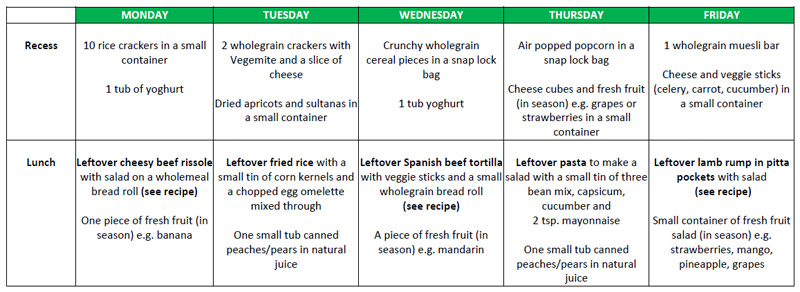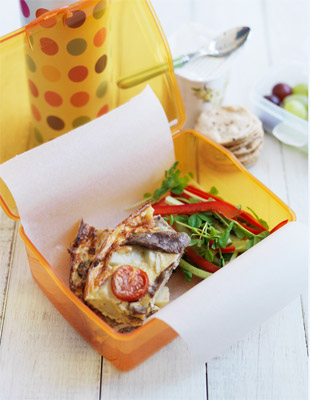Kate Di Prima Lunchbox Interview

Kate Di Prima Lunchbox Interview
With kids about to return for a new school year, new research has revealed Australian parents put over $2.75 billion dollars into their kids' school lunches every year while ignoring a simple nutritious solution to the daily lunch-box dilemma which could save the average household hundreds of dollars.
The survey, conducted by Galaxy Research on behalf of Meat & Livestock Australia, found that while the average family spends up big buying food for the lunch-box, nine in ten (89%) admit to throwing out uneaten nutritious leftovers from the fridge.
Not only is this adding to landfill, but it may mean missing out on critical nutrients in the lunch box. According to the survey, six out of ten parents of 5-11 year olds include a simple sandwich with spread in the lunch box which is low in protein. Using leftovers such as protein-rich foods like beef and lamb in the lunch box are not only filling, they are also packed with nutrients. Swapping a simple sandwich with spread for leftover roast beef and salad in a sandwich provides more than double the amount of iron, zinc, vitamin B12 and protein, making a valuable contribution to critical nutrient intakes for the average 5-11 year old.
Additional findings:
Using leftovers may help save time in packing the school lunch. Australian parents are spending 60 million hours a year between them making and packing lunches
Only one in five (21%) mums currently send their child to school with home cooked food yet more than two thirds (65%) are in favour of doing so
The main barrier to packing leftovers for lunch is that there's nowhere for their child to heat these up at school (63%) followed by a lack of awareness of how best to keep the food fresh (24%) and not being sure of the best way to pack the lunchbox (11%)
Accredited Practising Dietitian, Spokesperson for the Dietitians Association of Australia (DAA) and mother of two, Kate Di Prima comments: "The survey reveals that Australian parents are spending a lot of money and time packing the daily lunch-box, without considering one simple nutritious solution. Dinner is where most Australians enjoy a healthy, balanced meal; made up of a nutrient-rich protein food, such as beef or lamb, a variety of vegetables or salads, and grains like pasta or rice. This is the perfect combination of foods and nutrients for the school lunch box, to fuel kid's minds and bodies so they have enough critical nutrients and energy to be alert and concentrate at school."
"Leftovers can be enjoyed cold in the school lunch box or heated and packed into an insulated thermos container; an easy way to save time and money. Packing nutritious foods for school lunch, such as red meat, wholegrain bread, vegetables, fruit and dairy foods, provide critical nutrients, such as iron, zinc, protein, carbohydrate and B vitamins; important for energy and learning at school. Children who skip lunch may not perform as well in the classroom. Using leftovers from dinner, such as roast beef to make a salad or wrap, gives kids a nutritious lunch they will also enjoy eating," adds Kate Di Prima.
Kate Di Prima's leftover lunch-box tips:
To keep food fresh and cold, use an insulated lunch box and include a small freezer brick or freeze a bottle of water. Foods and drinks that are kept cool will be safe as well as more tasty and appealing.
Invest in a series of containers of various sizes and pack leftovers in tightly so they can't move around
Consider using an insulated thermos container so you can heat and pack hot food. These special containers can keep food hot until lunch time.
If you don't regularly have leftovers after the nightly meal, cook an extra serve of meat and vegetables or double your recipe to ensure leftovers for lunch the next day.
Nutritious leftover lunch suggestions (which don't need to be re-heated) :
Roast lamb can be sliced and used in a pita pocket spread with hummus, lettuce and carrot
Leftover rissoles or meatballs can be sent as a healthy burger on a wholemeal bread roll with sliced cucumber, lettuce and tomato sauce
Leftover fried rice is perfect for the lunch box. Add a protein-rich food such as leftover diced meat, chicken or egg omelette
Chop leftover roast meat and roast vegetables into bite size pieces and mix with lettuce for a nutrient-rich salad

5 Day Lunch Box Meal Planner :
Recess and lunch provide a 'pit stop' for kids to refuel their energy levels. A healthy and inviting lunch includes a variety of foods from the different food groups.
Aim to include at least one serve from each food group:
Protein-rich foods - beef, lamb, chicken, fish, eggs, tofu and legumes
Fruit - a variety of fresh, canned or dried
Dairy or soy - cheese, milk or yoghurt
Vegetables - a variety of different coloured vegetables
Grain and cereal foods - wholegrain bread, crackers, rice, pasta and noodles
Plus Water - it's the only drink kids need
Food safety - Keep it fresh It is important to keep food in the lunch box cold to inhibit the growth of bacteria. Use an insulated lunch box and include a small freezer brick or freeze a bottle of water. Foods and drinks that are kept cool will be safe as well as more tasty and appealing.
For recipes, please visit: www.femail.com.au/back-to-school-lunchbox-recipes.
Interview with Kate Di Prima
Kate Di Prima is an Accredited Practising Dietitian in Brisbane with more than 20 years' experience. She runs two private practice clinics and provides corporate consulting services to many companies. The author of two cookbooks, lunchbox cards and co-author of two self-help books, she is passionate about the health and nutrition of families. Kate is regularly asked to present both nationally and internationally on topics relating to children's and family nutrition. Kate has two children: Jack aged 12 and Rosie aged 9.
Question: Why did you decide to become a part of this campaign for The Main Meal?
Kate Di Prima: I am a mother of two; I have a nine year old and a twelve year old and I have been a dietician for 21 years, I specialise in paediatrics. From a professional and personal point of view I've seen how good lunchboxes can be and what they can give a child during the day but I've also seen lunchboxes that fall short of the mark as well.
Providing some simple, easy tips is something that I am really passionate about.
Question: What are the most important nutrients that should feature in a lunchbox?
Kate Di Prima: There are a number of things:
Kids need a sustaining main product which could be a wrap, a roll or a salad which can incorporate last night's dinner. A lot of parents that I speak to have run out of ideas and all their kids seem to want are Vegemite sandwiches and that is just not sustaining enough to get them through the day. Kids need something that is high in protein and iron (red meat, fish, chicken, egg, legumes (baked beans, hummus)) which is important to help transport oxygen around the brain.
A piece of fresh fruit whether that be chopped up into shapes or left whole as children need at least one piece of fresh fruit in their lunchbox, every day.
Dairy is also needed in the lunchbox whether it be yoghurt, milk or cheese which can be soy or goat based if the child cannot have cows milk.
A vegetable item is also needed in the lunchbox, I will quiet often include cherry tomatoes or wheels of cucumber or carrot which can feature in the main meal or separate for them to munch on throughout the day.
Don't forget fresh water, as well!
Question: How can Australians find inspiration, in the fridge?>
Kate Di Prima: Last night's dinner or other leftovers are a great idea for the lunchbox because children have been exposed to the food the night before and there are no surprises. There are a number of different cookbooks out there that show amazing things to include in the lunchbox but they are very time consuming and many children will open the lunchbox and if they haven't seen the food before they may be a bit fussy and veer away from it. Whereas, last night's dinner has already been eaten by the child and they know what it tastes like.
If you have Spaghetti Bolognaise you can warm it up and put it into a thermos and it will stay hot for a couple of hours and it is easy for kids to eat and it's quick and easy for you because you don't have to come up with any extra ideas plus it's cheap because you've already made it, the night before. Leftovers are also very nutritious!
Question: How can mothers keep school lunches fresh and appealing so kids don't throw out or trade their food?
Kate Di Prima: It's important to talk to your child about what they consume in their lunchbox and a lot of schools these days don't allow children to throw food out and what is uneaten in the lunchbox comes home so the parents can talk to their child about that. We do have kids who will trade their food at school and many kids will share half their food with each other and that is difficult for parents to manage but the bottom line is if they like their lunch, that they are sent to school with, then they are generally going to eat it.
This weekend parents can sit with their little ones and plan their lunchboxes for the week and explain the foods included. Parents can also put stickers on foods so children know when to eat which foods such as a blue sticker for foods eaten in the first break which will help guide children through their lunchbox. Many parents make the mistake of putting too many things in a lunchbox, it's not a tackle box and overfilling can overwhelm children.
It's important to also check with the policies of the school in terms of nuts and other foods that aren't allowed in the school yard due to allergies.
Question: Is it possible to keep school lunches fresh?
Kate Di Prima: I'm located in Queensland and I'm always asked "how can I keep the lunchbox safe?" and generally if you have an ice-brick it will keep the lunchbox fresh whether that is a designated ice-brick or a frozen water bottle whilst freezing fresh fruit such as oranges and grapes provides an extra ice cube in the lunchbox to keep the food cold.
Ensure that the lunchbox seals well and then you can put the lunchbox into an insulated pack. Most schools now have racks inside, out of the sun, for lunchboxes. It is important that you ask your child, not to leave their bag and lunchbox in the sunshine which will help it stay nice and chilled.
On the other hand I have done many tests of food that I have heated and then sent to school in a thermos and used a temperature gauge to check to ensure it stays outside of the bacterial growth for a long time. Children's lunchboxes do not have a great risk of bacterial growth if you follow correct preparation and food handling.
 Question: What is a typical lunchbox for Jack and Rosie?
Question: What is a typical lunchbox for Jack and Rosie? Kate Di Prima: A typical lunchbox for my children would be last night's dinner which was Spaghetti Bolognaise and I would use the Bolognaise either in a wrap, sandwich, on crackers or use it as a dip. My daughter may ask for the leftovers to be heated and put in a thermos, especially in winter. I also include a tub of yoghurt, a tub of hummus with carrot sticks and then a snaplock bag with grapes, strawberries, kiwi fruit or another piece of fruit. If we've done some home baking they may have a little muffin in their lunchbox but it does depend on whether they have sport, that day. Fresh water is a must, kids do not need cordial or soft drink, fresh water is perfect.
Question: How can parents approach the subject of the school canteen?
Kate Di Prima: It is difficult nowadays and a lot of parents have said to me that when they were at school they had tuckshop food all the time but the complexity of things these days is that there are many after school events and children's birthdays that include cake and lollies as well as activities such as swim classes and soccer which are places where children can access sugary, salty foods and soft drink.
I tend to say to parents to utilise the tuckshop for the main meal once a week whether that is for a ham and cheese toasted sandwich, curry, a healthy pizza or fried rice. Accessing the main lunch meal is important whereas food like chips, sausage rolls, sweetened drinks are party foods need to be limited and not be consumed at school.
The tuckshops now expose children to different foods which are really important. Many school tuckshops now coordinate their food to fit with healthy guidelines that ensure lower salt and sugar in foods. However in amongst the healthy foods there are treat based foods that don't help with concentration and many teachers throw their hands up in despair when they see what the Preps, Year 1s and Year 2s are eating for lunch!
Interview by Brooke Hunter
MORE



